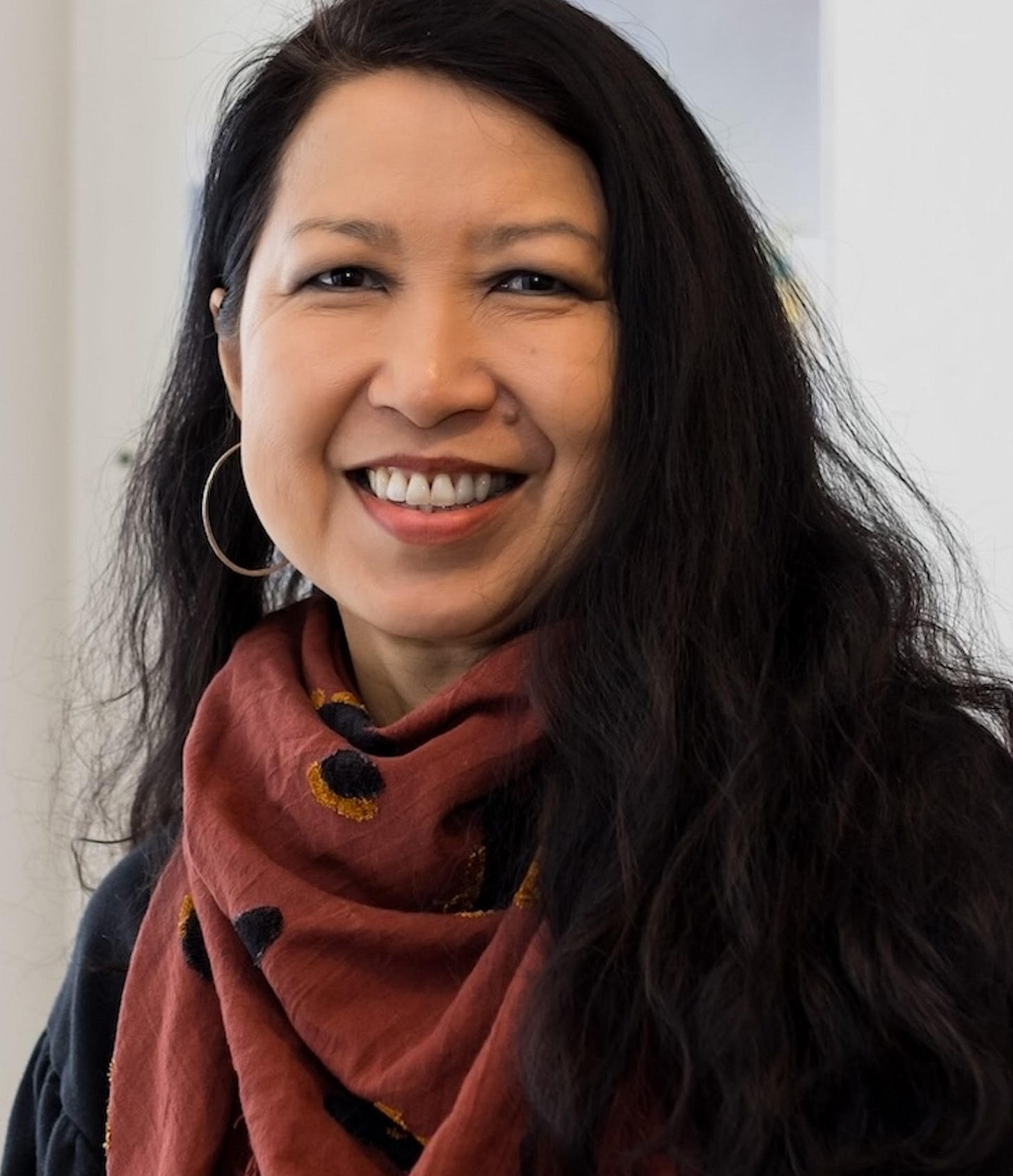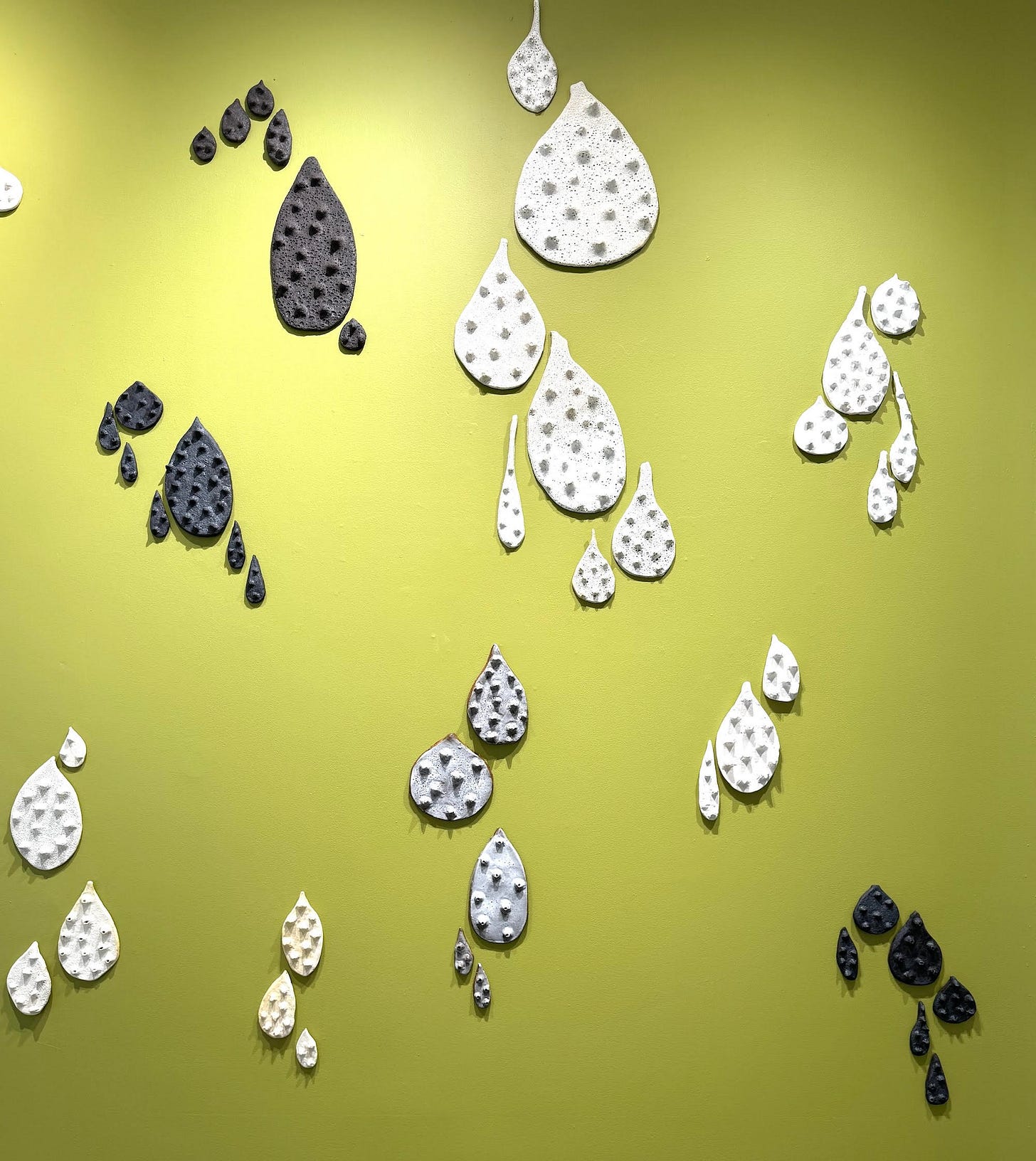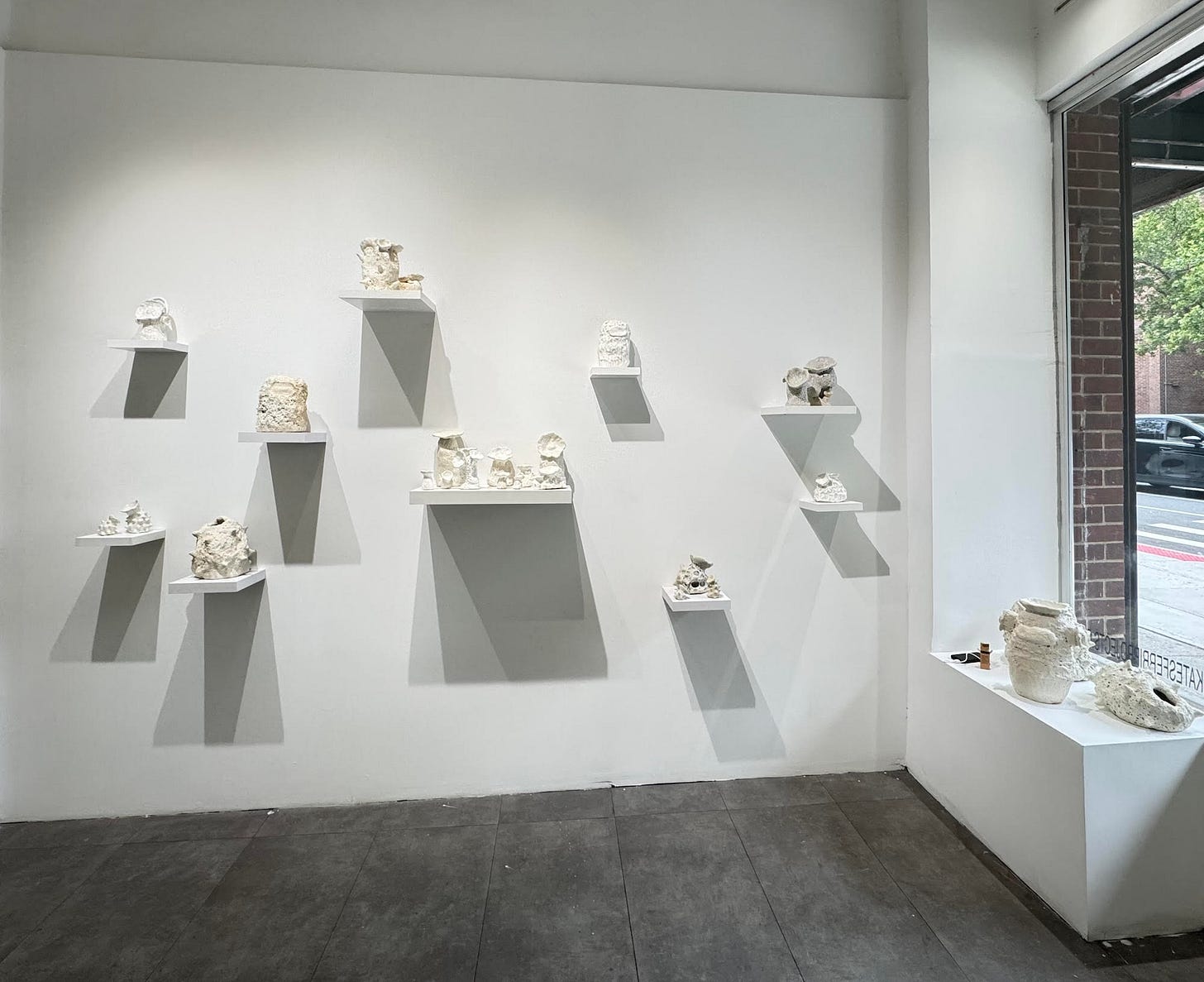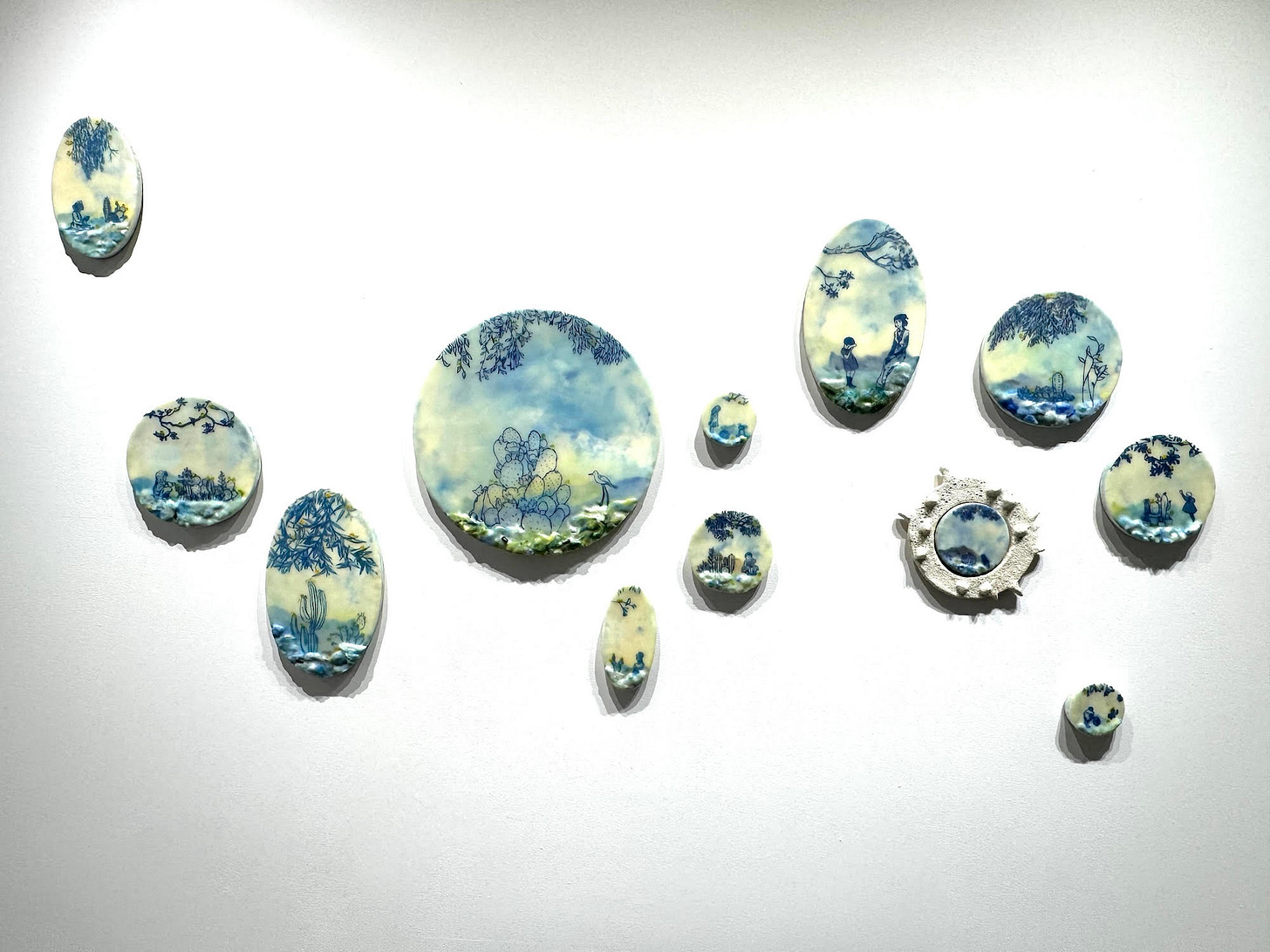Kaleidoscopic No. 32: Cecile Chong
Leonardo Bravo:
Hello this is Leonardo Bravo and after taking a bit of a break I’m back doing interviews with Kaleidoscopic Projects. I’m excited to chat here with Cecile Chong since it’s been so great to have met you recently in New York and to see your wonderful current exhibition at Kates-Ferri Projects gallery in the Lower East Side. I thought we could start off with a basic framing about your practice and then get into specifics about the work itself.
Cecile Chong:
Hi, Leonardo, thanks again for having me and I'm really excited to be featured at Kaleidoscopic. So I’m Cecile Chong and I'm a multimedia artist working in painting, sculpture, installation work. I also work with public art, and I flirt with videos, especially stop motion animation. Through this I layer materials, identities, histories, and languages and my work addresses ideas of cultural interaction and interpretation, as well as the commonalities that we share as humans, both in our relationship to nature and to each other. I also love to be inspired materials and I use them as signifiers of a culture or a place. I'm super interested in how we acquire and share culture and how world cultures nowadays they're overlapping and interacting in ways that we have not seen previously. I'm also curious about looking into the fragility of our current moment and civilization despite the commonalities of a cultural foundation.
Leonardo Bravo:
I was so impressed by you current show at Kates-Ferri Projects which brings to life these multi layered approaches and mediums you have on exhibit.
Cecile Chong:
So this is my second exhibition with the gallery and Natalie Kates has also included me in other group shows as well in exhibitions off site. The current exhibition is titled Sphere Not and it's curated by Tessa Ferreyros and it's been really a wonderful experience working with both of them. Natalie always provides so much support and creative freedom with my practice and I'm also very thankful for her support of and commitment to BIPOC artists. She always brings artists to show in her gallery from Latin America, Africa, and other parts of the Global South. Tessa and I have worked together before through Art in Buildings and she has a really sharp eye for nuance and I appreciate how she can capture and understand the cultural references and subtleties in my work. The full title of the show is Sphere Not: The Global Immersive Sensory Experience. I feel like we are living this global experience that we're completely immersed in it already.
Leonardo Bravo:
There’s certainly an immersive sense to the whole exhibition that takes you on a bit of a journey.
Cecile Chong:
It’s an exhibition in four parts, and someone the other night called it four chapters and under the same umbrella. So it's really a reference of how systems of culture and commerce distract us from the fragility of our current moment with comforting illusions. It’s also a commentary on The Sphere in Las Vegas, this massive entertainment arena that is ultimately an energy consuming structure. I got to see a show there this past February that ironically was about planet earth and projecting messages about protecting nature but the tickets were going for over $150 per person. And I felt like, okay, that's a major contradiction. Meanwhile, to keep this spectacular sphere lit up every night, it takes so much extraction from the earth and so much energy. So the title of the show is really meant to poke at this contradiction. There’s a sphere, a disco ball as part of a video installation and it includes the footage that I put together during my residency last year at Art Omi in Ghent in Upstate New York.
Cecile Chong:
I spent three weeks there and I was filming these natural and pastoral surroundings. For the soundtrack I included various renditions of this Latin American song called La Llorona, meaning the weeping woman. The song is originally from Mexico in the 1930s and the lyrics are about a mother who drowned her children, but I really use them as a metaphor to reflect how we as humans, how we are harming something that we love which is nature.
And from there I tried to draw some attention that would serve for this metaphor and the disco ball in the video projection symbolizes how forces in our culture distract us from real issues, from facing the reality of an ongoing climate catastrophe. And the way I projected the video was also like a book format. It was off center, completely off center, and I wanted it to look like the pages of a book that we would kind of flipped in the not too distant future. And looking at images of nature as if from the past is also about humans betraying nature, how we've been coexisting, but also how we have been overly extracting, destroying, burning, and creating pollution.
Leonardo Bravo:
There’s a real sense of grief and collective mourning that comes across in the exhibition related to these themes of extraction, displacement, and the betrayal of our relationship to nature.
Cecile Chong:
Another part of the exhibition is a wall of wailing cactus and they look like tears made out of ceramics. This piece traces the liminal grief of the video piece, of nature itself weeping. But I'm also emphasizing the interconnectedness and resilience. I view cacti as a symbol of the Americas. I’ve been really inspired by my visits to the Galapagos Islands recently and I went back to the islands for the third time. And walking around, Isabella especially, where I saw fields and terrains of the whole island covered by amazing cacti formations. This connects also to a public garden installation that I created and was installed on Staten Island last year which spoke about this interconnectedness. I feel that for immigrants from Latin America, the cacti is almost like a close connection, a symbol of home, a symbol of welcoming. So that was my intention of that public sculpture.
Leonardo Bravo:
What about the other ceramic pieces which have a more organic feel?
Cecile Chong:
My ceramic sculptures, and I've been working with ceramics for six months now as I started at the end of the year, with these I’mmixing clay with volcanic ash from a few volcanoes that erupted in the past 10, 15 years outside of Quito my hometown in Ecuador.
And the forms also are an extension of my guagua sculptures that evoke creatures or objects that could be found or unearthed from land and sea. I really love how people are interpreting them, that they can be objects from the ocean and also mushrooms or fungi, or whatever you find on the land. It’s important for me to have these sculptures installed as in an anthropological museum, but also referencing a gift shop. I'm thinking about one of my favorite museums in Quito, Museo Casa del Alabado, and they have a wonderful collection of pre-Colombian artwork and objects that I've been looking at my whole life. I get really flattered when quite a few visitors have told me, oh, this reminded me of pre-Columbian art.
Leonardo Bravo:
I thought your encaustic wax paintings have such a magical feel emphasizing a sense of innocence and child like wonder and the surfaces are also so inviting.
Cecile Chong:
These are my encaustic paintings that I call my blue series and that I've been painting for almost 20 years. There are a few common elements in my work and one is that I continue researching material and using them as different signifiers. So I have volcanic ash and I have materials from circuit boards, and for me these circuit boards represent how across all of humanity technology has become ever more prevalent. I'm also including rice paper and I appropriate figures from different children's books from east and west to reflect part of my upbringing. I should also mention about encaustic, which is a very ancient medium. If you look at mummies from Egypt, the funerary portraits are made out of the same encaustic material and these portraits are more than 2000 years old. In a way I hope that my own work would last as long. Another element of my work is that I wanted to include a Latin American element to my paintings at the beginning and I thought about how I grew up watching indigenous women carrying their babies on their backs and I was always fascinated by them. And someone told me that the babies were swaddled very tightly with fabric material and that a good swaddle was when the baby could stand on the table like a bottle.
I became obsessed with that information and I thought, what can I do in New York City as an artist with that information. It wasn't too long after that that I couldn't sleep and I became obsessed with the idea until one night I just woke up and I went to the recycle bin in my kitchen and I took out a bottle and I started swaddling it with burlap and plaster. So a body of work came out of this and there are three dimensional forms, but they also show up in my paintings as include them as a two dimensional element that I put them in my branches or as flowers of fruit and also on the ground like rocks or other elements of nature. And for me, they represent a tabula rasa, blank slates, representing humanity.
Leonardo Bravo:
It’s so interesting so see in your work how you configure and re-contextualize various cultural histories. These values are very purposefully woven into your work. How did this come about for you?
Cecile Chong:
To me there’s also the question of nature versus nurture. How we are shaped, is it because of our parents or is it because of our environment? Also with the blue and white. It reflects my ongoing research into this ceramic tradition that I'm going deeper and deeper into this research. Through this I’ve come to realize how inter-cultural exchange has always happened and objects and people have moved around from the beginning of time. So there's nothing unusual about migration especially when it comes to blue and white ceramic ware. It makes me think about the Silk Road when China had the ceramics and porcelain techniques but then Iran and Iraq had the cobalt blue pigment which is the primary source for blue and white ceramics. So I love learning about that early cultural interaction and exchanges as blue and white ware went all over all Asia through the Middle East, and ultimately arriving in Europe.
And through every step it became its own thing. I also love learning about the Manila Galleons that came out of the Philippines once a year and headed to Acapulco, Mexico. It started from, I believe around 1565 and went for 250 years through these two colonies of the Spanish crown. Many of the luxury goods that were exchanged were silk but also a lot of these blue and white porcelain that were made for export. And in Mexico it became the Talavera Poblano style that adapted and incorporated Spanish, Chinese, and Indigenous Mexican elements.
I find this interracial cultural heritage through blue and white wares fascinating and I how many different cultures throughout the world have participated in their creation. Recently this year, Monica Ramirez Bernal invited me to have a conversation with her at The Met about their collection of Talavera Poblana ceramics and the two of us had a really great conversation which was an opportunity to highlight how these techniques have accompanied humanity and have traveled and evolved across continents and centuries.
Leonardo Bravo:
What were some of your own inspirations along the way, either through your upbringing, family, education, mentors?
Cecile Chong:
My early inspirations came from small but transformative moments in childhood. One of my first memories is of cutting out paper dolls, what we called “cucas” in Ecuador, at the age of four. I would sit on the floor, turn a chair around, and make it my desk. Soon after, I started making my own paper dolls. Drawing, coloring, outlining, cutting, all created a magical feeling of focus and immersion, something I didn’t yet recognize as art, but now see as the beginning of my artistic practice. As I grew up, I was constantly searching for that sense of wonder and creative concentration.
While living in Macau, I didn’t have formal art classes in middle school, but I found great joy in my Chinese calligraphy class, held every Thursday during the last period. It became the highlight of my week, a small pocket of time where I could engage with material and mark making.
My grandmother Carmen was one of the most significant influences in my youth. My sister Romy and I attended the Sacred Heart Catholic School in Macau, while at home, we lived with a very superstitious and deeply Buddhist grandmother. The contrast was intense, but it shaped how I understood the coexistence of different belief systems. Carmen was an extraordinary cook, played Mahjong daily, loved the casino, and had an incredible talent for storytelling. She was feisty, highly resourceful, and always hands-on. She taught me beadwork and different types of crafts and instilled in me a strong sense of discipline and work ethic. Despite being illiterate, she navigated life with remarkable intelligence and adaptability. I often think about how much she shaped my outlook. I dedicate my formal education and my many years of teaching to her.
As a teenager in Quito, I didn’t grow up visiting museums, but I spent hours at local artisan markets in the city and in Otavalo, a town in the Andean highlands. I was deeply inspired by the artisans, watching them transform local materials every few months, responding to the seasons, festivals, and community needs. Their ability to create beauty out of what was available taught me to value process, resourcefulness, and cultural specificity. I was also deeply aware of the indigenous presence in Quito. Even as a child, I questioned why I was sitting in the international section of an American high school learning English, instead of learning Quichua/Kichwa, the language of the indigenous communities around me. That early awareness of cultural belonging, displacement, and language politics continues to inform my work today, shaping both the content and the materials I choose to engage with as an artist.
Leonardo Bravo:
It’s so inspiring to hear about these incredibly vivid formative stories. Cecile, you shared about about your identity from an Asian diaspora perspective in Latin America. How has that informed your work and how does it inform your involvement with collectives such as Asianish?
Cecile Chong:
I was born in Ecuador to Chinese parents. I’m second-generation Chinese in Latin America. My grandparents migrated from Canton to Peru and later to Ecuador. I was born in the coast. My family moved to Quito when I was three, and I lived there until I came to New York at 19 to study art. Between ages 10 and 15, I also lived in Macau with my grandmother. The first two decades of my life were spent in a constant cycle of learning and forgetting languages—Spanish, Cantonese, Hakka (a minority Chinese language), and English.
Over time, I’ve learned to describe my sense of “home” in layers:
China is my ancestral home,
Quito is my emotional, psychological childhood home,
New York City is my art home.
Being Chinese Ecuadorian means living with a sense of invisibility. There’s little research or recognition of the Chinese community in Ecuador, what’s often referred to as the “Overseas Chinese.” Even during something as routine as renewing my national ID in Quito, the absence of an “Asian” category reminds me how unrecognized we are on paper. It can feel like being a permanent stranger, both in my own country and elsewhere. It could be sad and I don’t spend time dwelling on it, but I do acknowledge the reality of erasure and how that shapes identity.
This lived experience has informed much of my work and my involvement with Asianish, a collective I co-founded with artists Maia Cruz Palileo, Sara Jimenez, and curator Gabriel de Guzman. Asianish grew out of a conversation during a NYC Creative Salon in 2018 around the theme of “identity.” That dialogue was so meaningful we knew we needed to continue creating space for these layered, hybridized Asian/South/Southeast/East Asian diasporic experiences. Asianish now includes over 300 members. We hold space for complex, intersecting identities, embracing the fact that while many of our stories overlap, each is also deeply unique. Together, we share our practices, honor our histories, and support one another—strengthening our community within and beyond Asianish.
Leonardo Bravo:
Cecile, it’s such a treat to hear about your work and life story and how all of this is woven into a tapestry of complex and enriching connections. Thank you for your time today and I hope folks get to see your work in person at Kates-Ferri Projects in the Lower East Side in Manhattan, NY.
Cecile Chong:
Thank you Leonardo and it’s been my pleasure as well.
For more information:
https://www.katesferriprojects.com/exhibitions/sphere-not-cecile-chong
IG: @cecilestudio









